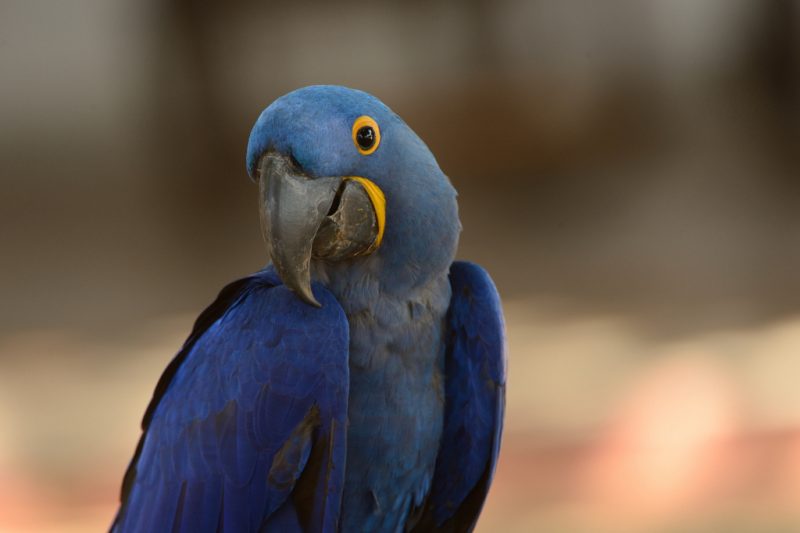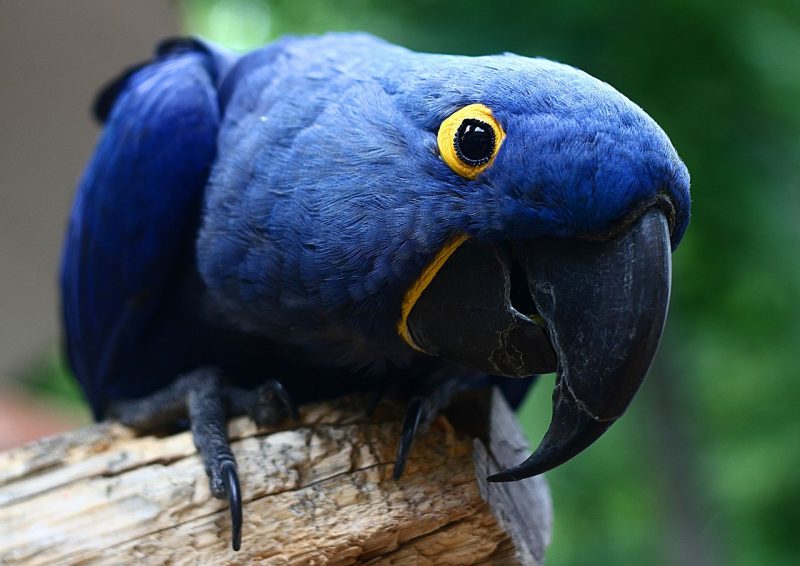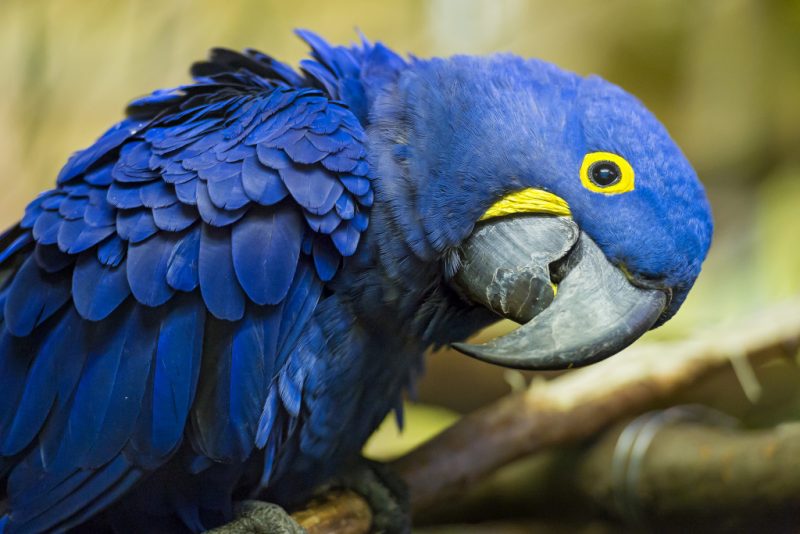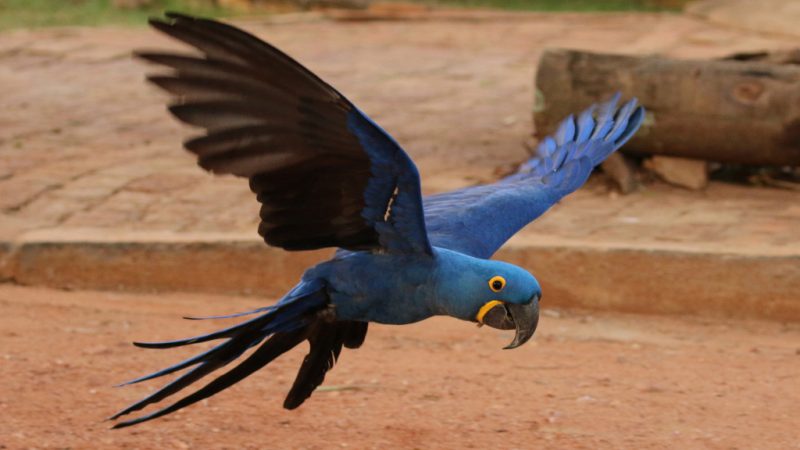Lovers of everything unusual and exotic have not been limited to cats, dogs and hamsters as pets for a long time. They were replaced by chinchillas, boas, and, of course, overseas birds. One of these winged wonders of the wild is the hyacinth macaw. What is this bird and how to keep it in captivity?
Material Content:
Description, habitat
In various sources, this bird appears under the names small hyacinth macaw or large hyacinth macaw. In fact, this is one and the same kind of parrots. Truly gigantic sizes distinguish them from other relatives.

The body length of the blue parrot is able to reach a mark of 100 cm, half of them fall on the magnificent tail. Is it any wonder that this feathered giant weighs about 1.5 kg.
The color of the plumage of the macaw has a rich cobalt-blue hue. Color can be of different intensities - such birds are also called gray-blue hyacinth macaw. Feathered paws are gray, black beak.

It is interesting. The sizes of the beaks of the male and female of the blue macaw are usually different - in ladies they are much smaller.
Small areas around the eyes of the bird are completely devoid of plumage - as is the area of the mandible. They have a rich yellow color.
You can meet these wonderful birds in the vast Brazil, Bolivia or Paraguay. These birds live in forests, where it is easier to find food and hide from predators. They love macaws and fresh water bodies, to which they periodically fly to quench their thirst.
Hyacinth Macaw Life Span
Despite its massiveness, macaws are easily tamed and coexist in captivity. These birds can often be found in zoos and among exotic lovers. The maximum recorded lifespan of a tamed macaw is 39 years. There is evidence of a 54-year-old overseas feathered, but they are not documented.

It should be noted that due to the relatively long life expectancy, as well as the difficulty of fixing the age of birds, periodically there are data on parrots that have reached the venerable age of 50-90 years. It is believed that this information is false.
The nature and lifestyle of the bird
Blue Macaw is extremely fond of the company, so it is quite difficult to meet a lonely individual in nature. Usually these birds make pairs and even keep in groups. Hyacinth macaws are most active during the day. They knock in tight flocks, settle on tree branches and preen themselves, inducing a "marafet". Then they go in search of food. Macaws feed on berries, fruits and snails. Ara are wonderful flyers who are able to cover significant distances up to tens of kilometers.

Blue macaws and monogamous couples create once and for their whole lives. The mating season is from February to June; clutch usually consists of two eggs. The female hatches them for a month, the male protects the family and provides the spouse with food. Parrot chicks naked and blind. At three months they are already able to leave the nest, but remain dependent on their parents for about six months. Sexual maturity and the ability to reproduce in birds occurs at about 6-7 years.
Interesting facts about the blue parrot

Years of observations by researchers and naturalists on bright macaws made it possible to highlight several interesting features of these birds:
- Hyacinth macaw has a very strong and piercing voice, which is heard at a distance of 1.5 km from its habitat.
- These large parrots are extremely dexterous. They differ from other birds in the original arrangement of fingers: two of them look forward, and two - back. This is what allows birds to grab objects with their paws, just like a person’s hand.
- Blue Macaw is famous for its greed. Having discovered a tree with fruits, he begins to eat seeds, revealing them with his beak. At the same time, the bird does not make a single extraneous sound, so as not to attract other hungry counterparts.
- You can also note the trick of parrots, combined with a reluctance to work. This is especially pronounced in palm nut harvesting situations. This fruit is loved not only by macaws, but also by cows. The latter are attracted by the soft walnut shell. Cows swallow nuts, their soft part is digested, and the nut itself passes through the entire digestive tract of the animal. Thus, it gets out practically intact. This will use the macaw unwilling to mess with the outer shell.
- Unlike other types of blue macaw parrots, there is no desire to imitate human speech. The fact is that in the vocabulary of these giants there are enough own sounds, which a parrot can create more than 17.
Care and Maintenance Tips
The wonderful blue parrot requires some care, ranging from cell size to dietary features.

When planning to have such a companion, you should consider several basic recommendations for its content:
- The content of hyacinth macaws suggests the presence of large areas. The cages (aviary) should be quite spacious, the rods enclosing them should be strong (a parrot can easily bite thin fences). The condition of unlimited space is extremely important - a parrot must be given the opportunity to freely spread its wings. In this regard, many owners are sure that no cage, even the most spacious, will not replace a separate room for a pet.
- The parrot needs constant motor activity. Therefore, his home should be equipped with various poles, ladders and ropes.In addition, a special sharpener for beak should be in the house.
- Ara is very fond of water treatments. For these purposes, a wide bath should be placed in a cage. You can teach a bird to frolic in the soul.
The pet must be fed with grain mixtures designed specifically for large parrots. Mandatory food products are seeds, berries, fruits, nuts, corn. Twice a week, pets are treated to cottage cheese and boiled eggs. The birds are not indifferent to various boiled cereals (unsalted).
Every day, the bird should be given fresh branches of trees, which she will be happy to nibble.
Cobalt macaws are considered ideal companions because they are trusting and friendly, reminiscent of an enthusiastic young child. However, the owners of these birds sometimes note that with all their apparent good nature, macaws can be vengeful and vindictive.
Important. Do not forget that Macaw is quite a companionable parrot. Deprived of society and attention, he will begin to get bored, while plucking feathers on himself. For this reason, such a parrot should not be purchased by forever busy people who are not able to devote time to their pet.
Exotic bird has remarkable intelligence. It is for this reason that parrots are often invited to work in a circus, because the macaws respond very well to training. They are easy to train in a variety of tricks, and they will proudly demonstrate them (dancing, bowing, etc.).
The good-natured giant will not allow himself to bite a person for no reason. But, if he considers that danger hangs over him, he is quite capable of standing up for himself with his beak.

By the way, Macaw is extremely curious and able to harm equipment, furniture and other things. The restless parrot seeks to reveal everything, to crack and by all means to get to the contents. Feathered food will certainly eat, and what is not suitable for food will be tested for strength.
The cost of a hyacinth parrot
The blue parrot is considered a rather rare bird, and therefore is not cheap - from $ 2,500 to $ 5,000. In some cases, the cost may even be $ 20,000.

The gorgeous parrot hyacinth macaw is the perfect companion pet for people who love active animals. A huge, good-natured handsome man will not let his master get bored and give him not only a good mood, but also his loyalty and disposition.












